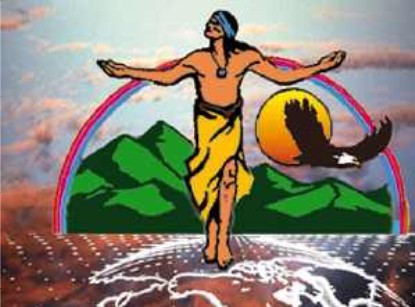The Fallen Goddess Scenario
Summary and Evaluation
Writings attributed to ancient seers known as Gnostics describe an outpouring of energy from the center of our galaxy that eventually forms the planet earth. This event and its consequences are recounted in the narrative of the fallen goddess Sophia, whose name means "wisdom." My summary of this "creation myth" uses a transposition of it mythic features into terms consistent with modern cosmology. Following the summary is an evaluation of what the myth tells us about life on earth, and how it may be corroborated by scientific finding, on the other hand, and mythology, on the other.
This entry is linked to the Reading Plan for the Nag Hammadi Codices which I have upgraded.
jll 2 October 2010
Galactic Dynamics
Framed in mythological language, this fallen goddess scenario (FGS) describes the core of our home galaxy as a vortex of infinite potential (Pleroma: fullness, plenum) consisting of massive serpentlike entities or torrents. The gods and goddesses of the Pleroma are called Aeons in the Gnostic writings. They are gendered male and female to describe different types of dynamic activity, like positive and negative charges of electric current, or the attractive and repulsive poles of a magnet. The Aeons are divine: that is, luminous, radiant, emanating light. They are also alive and intelligent and capable of feeling, perception, and desire, but on the level of cosmic consciousness. From the glossary of Not in His Image:
Aeon: (AY-on) (Greek, “god,” “divinity,” “process,” “emanation,” “time cycle”) Gnostic term for a cosmically pervasive process, aware, animated, and animating. Aeons manifest sensory worlds by dreaming, rather than by the artisanlike act of creation attributed to the biblical father god. Adj., Aeonic.
An Aeon might be envisioned as a massive current of living luminosity capable of sentient response, gesture, speech. The standard metaphor for such energies is "serpent. "The Aeons are serpentine but not reptilian. A snake is a reptile but distinct from a lizard, iguana, chamelion, etc. All things snakey and serpentine ought not to be contaminated by association with the dubious label, "reptilian."
The "outpouring of energy" in the FGS describes the central event in Gnostic myth: how one of the massive luminous serpentine currents swriling the galactic core burst beyond the boundaries of the core. Science today recognizes that the galactic core has a boundary, but a soft, porous one, like the yellow of an egg. The structure of our galaxy conforms to a standard model, the regular lenticular spiral: a egg-shaped rotating core surrounded by limbs or spiral arms. The extent of the rotating arms is vast, but the arms themselvs are thin, so the entire galaxy has the shape of a pancake with a central bulge. The dynamics of the core, the Pleroma, differ from the dynamics operating in the spiral arms, called the Kenoma, "deficiency, incompletion." This is the difference between infinite and finite potential. The core is like a fountain head perpetually erupting with boundless, undefined potential. In the spiral arms, this cosmic potential scales down into the relatively limited, but still immense, potentiality of celestial events, including planetary systems where experiments in life can unfold.
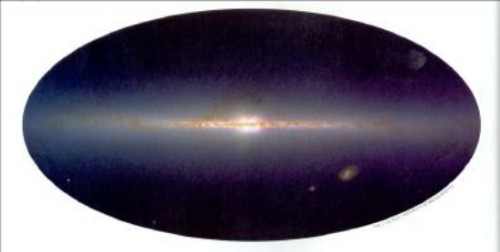
The galactic core or hub consists of a concentrated mass of high-energy currents, the cosmic gods. Its composite mass is pure stellar energy, the stuff that stars are made from, in a state of excitation that precedes and impedes the appearance of any particular form. Form arises in the Kenoma, the realm of finite potential. The composition of the outspreading galactic arms is not pure stellar luminosity but residue, the granular elements of past worlds. The entire galaxy is a vast glittering pinwheel that acts like a mill, grinding out future worlds from the residue of former ones. The dema, dense elementary matter arrays in the spiral arms, have some self-organizing properties but for the most part they are inert. The dema can produce suns, planetary systems, comets, nebular clouds, and so on, due to its own inherent dynamism, which is largely inorganic; but to produce living systems it requires activation from the galactic center. Hence, suns may be born and planetary systems formed in the dema, but for sentient life capable of self-awareness to appear in those worlds there must be a "input" from the galactic core.
In the normal course of cosmic events, Aeonic currents remain dynamically within the boundaries of the galactic core. To produce experiments in worlds arising in the galactic limbs, Aeons project their power of intention (ennoia) outward while remaining where they are. Consider the analogy of massive kleig lights inside a white canvas tent. The power generators, bulbs, and mounting apparatus of these lights remain within the tent, but they can project beams through the canvas walls. So do the Aeons, the cosmic divinities, project their intentions and designs into the Kenoma without engaging dynamically in the dema, the dense elementary matter arrays. Then they observe what happens in the interaction between the inorganic field of the dema and the sentient-organic projections they have "seeded" into it.
It could be said that the gods, the Pleromic Aeons, project myriads of Kenomic experiments to entertain themselves. This view of divine purpose recalls the Asian concept of Lila, "divine play."
Divine Mistake
And so it goes in the usual course of cosmic events. The designing powers at the galactic center—Aeonic headquarters, if you will—allow for free play of boundless potential, trial and error, novelty and innovation, in the experiments they initiate. The divine powers do not interfere with an experiment in progress, otherwise they would not be able to see how it plays out on its own terms. But there can be exceptions in the cosmic order, and Sophia's plunge is one of them. "The world as we know it came about due to a mistake," (The Gospel of of Philip). The "mistake" is an anomaly rather than an out-and-out error. Sophia commits a misstep or overstepping of cosmic boundaries and a mistake arises as a consequence of her audacity. Sophias's becomes enmeshed with the experiment she has projected, forced by her own compulsion, as it were, to go interactive with the subjects and conditions of the experiment. The dilemma faced by the goddess is the crucial plot factor of the fallen goddess scenario.
Of course, there may also be other Kenomic experiments where something similar occurs. Gnostic cosmology is a multi-world perspective, even a multi-galaxy perspective. The texts assert that there are many Pleromas. It may be that we will get optimal insight and benefit from the fallen goddess scenario if we consider it to be unique to our world, describing conditions specific to the earth. If the myth of the Aeon Sophia specifically describes an event in this galaxy with particular consequences for the planet earth and humanity, as I am convinced is so, then we would do well to concentrate on our unique situation before speculating on what happens elsewhere or, ultimately, what happens in the scope of the Universe, the totality of all galaxies.
The recognition that the fallen goddess scenario tells the story of OUR planet exclusively, and so engages humanity in an urgent and intimate way with the "earth goddess, " presents a block for some people, I have noted. Interest in this particular galaxy, the planet earth, and the conditions of human existence in this unique habitat where we are, may act as a deterrent or self-selection factor. I have noted that some people don't care for this limited scenario, preferring to go beyond it toward a larger picture. I would argue that the larger picture will come into view when our perspective here on earth is clear, including our view of the origin of the earth and the role of the human species in terrestrial design.
But this earth-first view is not attractive to some people who (it seems to me) assume that some abstract vision of the larger picture will automatically make our situation on earth clear and comprehensible, if not purposeful. A Gnostic would advise cautious scrutiny of any cosmic perspective that overlooks the particular fate of the home planet, Gaia.
The Sophia Mythos, as it may be called, is not, technically speaking, a creation myth like the Biblical account of creation in Genesis. Rather, it is an emanation myth consistent with the Aboriginal paradigm of the Dreamtime and the Hindu mytheme of "Vishnu dreaming," i.e., the oneiric paradigm. From Greek oneiros, "dream." Oneiric: of or relating to dreams or dreaming.
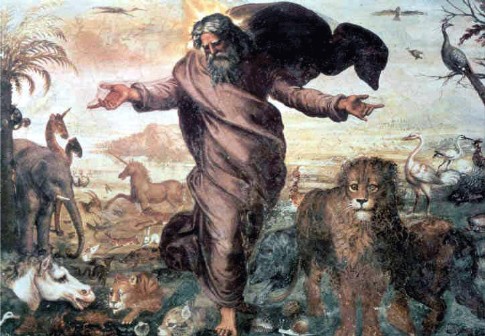
Atypical image of the paternal deity or Father God creating the world and its creatures. Unlike the male creator, Sophia does not make this world of ours, she makes herself into it. She does not create the animal species by divine fiat, she dreams them empathically. Theologically, emanation is a paradigm of immanence, placing the generative force of divinity with and in the world, permeating it. No matter how hard apologists try to say otherwise, the Father God does not permeate the world. The creator remains distinct from his creation, transcendent, omniscient, off-planet. The above image is atypical because shows the creator in the midst of his creations, rather than stationed in the clouds (i.e., some heavenly zone beyond this world).
The analogy to dreaming is a metaphor, if you will, but not just that. The oneiric paradigm describes a dynamic process in which life on earth is sustained in the way a dream is sustained by the dreamer. The characters in a dream exist and act as long as the dreaming continues. In the creationist paradigm, the creations persist after the initial fiat of the creator that brings them into existence. In Sophia's dreaming, called apporia in the NHC, terrestrial life persists as the dream activity concurrent with it unfolds. The creationist paradigm allows for humans to have a relationship to the off-planet deity, usually realized in an act of faith, but relating to Gaia-Sophia is interactive and experimental. We know Gaia in the immediate sensuous presence called nature, but interacting with her dreaming requires a dialogue with the mind of nature, the indwelling intelligence or Anima Mundi ("soul of the world").
In short, this habitable world of ours has not been created as an artifact, like a pot made by a potter, but is continually being emanated by the Aeon who dreams it. The assertion that the world was not created once and for all but is continually emanated is a first-hand truth of experimental mysticism, attested by many mystics and psychonauts who have enjoyed this mysterious dynamic perception both with and without the use of psychoactive agents.
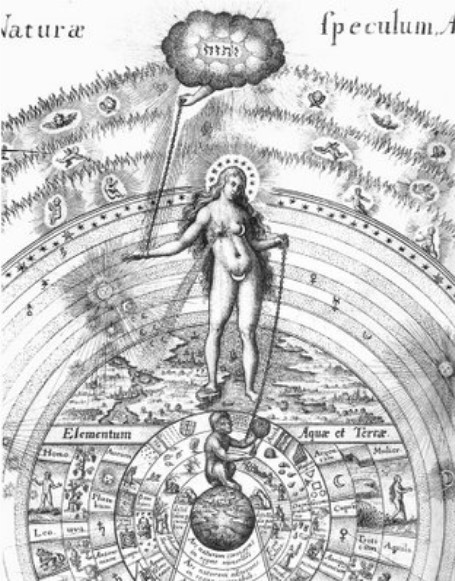
Well-known image of the Anima Mundi from an alchemical text. It shows the continuity from an extraterrestrial Pleromic realm (cloud with Hebrew lettering and extended hand) to the Divine Sophia to the rational mind of humanity (squatting monkey), with many divisions of the celestial and terrestrial elements. The entire ensemble might have been conceived with this line in mind: "All natures, starting from the revelation of chaos, are in the Light that shines without shadow, and indescribable joy, and unutterable jubilation" (The Sophia of Jesus Christ, NHC III, 4. 20). The Light that casts no shadow is the Organic Light, the primary substance body of Sophia and all the Aeons, contrasted to her planetary body, the earth.
Consider again the "mistake" that produced this particular world of ours: the compulsion of an Aeon to be engaged in an experiment projected from the Pleroma, the galactic core. The FGS describes how Sophia actually morphed into the planet earth. Her mass of living luminosity of Organic Light turns into the planet we inhabit by a process of condensation and densification. Sophia does not create the earth at all: she becomes the earth.
Nor does Sophia create humanity. At least not in the way the paternal deity of the Bible creates Adam and Eve "in his image." Gnostic writings explain that the Anthropos, the genomic template for humanity, is at first a featureless singularity produced from the Originator. called propater in the Greek loan-words in the Coptic books. The Originator is the monistic source of the multiple Aeons. Then the featureless singularity, an explosion of pure undefined possibility, comes to be configured by the Aeons of our galaxy into an experimental projection that will be implanted into the galactic arms. Variations of this event can be found in different texts.
One version says that two Aeons, Sophia and Christos, undertook the encoding of the human genome (Anthropos). These two Aeons are as it were the "parents" of the human species, but not in a biological sense. Christ and Sophia make a syzygy, a dyad or cosmic coupling. Once they have configured the ground plan for the human genome, encoding it with countless capacities and talents, they join the entire Pleromic company to release it into the galactic limbs. The Anthropos then emerges from the cosmic center as a projection of the divine imagination of the gods, not a creature made in the image of any god. Such is the grand vision of the Mysteries on the origin of the human species.
Gaia Mythos is a multi-world scenario, so the Anthropos template may be conceived as the matrix of many strains of the human species, able to emerge in many Kenomic experiments unfolding in the galactic limbs. But again, the Mythos is about one particular strain of humanity on that one particular planet subject to the anomalous plunge of the Aeon Sophia. The uniqueness of this story cannot be overemphasized.
Nine Episodes
Although allusions to a feminine deity identified with the earth
are widespread in mythology and indigenous lore, they are fragmentary and anecdotal. Gnostic materials
present the unique case of a complete and coherent scenario describing
how such a deity on the cosmic level turns into a planetary
body. Only the FGS of Gnosticism presents such a complete narrative about a goddess who morphs into the planet earth.
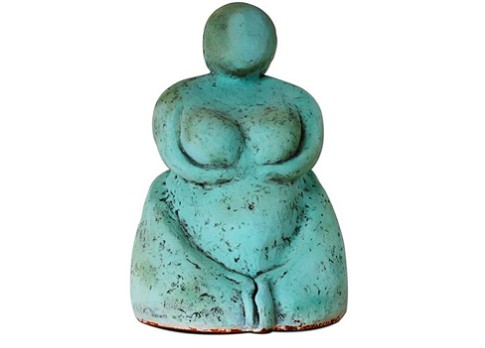
Due to the sparse and fragmentary condition of the surviving textual evidence, the fallen goddess scenario has to be reconstructed, sometimes by extrapolations from slim and scattered clues. The lamentable state of the NHC requires imaginative reworking of the mythos. This task benefits from a transposition of the mystical and symbolic language of the Gnostic materials into astronomical terms, as seen above. Modern science itself is largely an imaginative exercise—the fantastic scenario of "black holes," for instance.
Sculpture by Binna Green. The tendency to represent the planet earth or the totality of nature by woman's body is universal. Why? In the Hero - Manhood and Power, I pointed out that models of the abstract totality of the universe almost always use the male body, whereas some intuition in us sees this planet and the natural world as female. This is not mere anthropomorphism; rendering something non-human in human terms. The earth is Sophia's body, literally speaking. This is not a metaphor.
For more on extrapolations and astronomical language, see Coco de Mer, Part One: The Human Role in Gaia's Dreaming, and the Commentaries on the Gaia Mythos.
The complete scenario can be summarized in nine episodes:
1. A singularity, the potential for a unique divine experiment, emerges in the galactic center (Pleroma)
2. Two divinities (Aeons) in the galactic core, Sophia and Christos, configure the singularity into the Anthropos, i.e., they encode template of the human species
3. The divinities of the cosmic center collectively project the Anthropos into the galactic limbs where it can emerge and evolve experimentally in many worlds
4. Fascinated by the possibilities of the human experiment, and compelled by a desire to be involved in it, the Aeon Sophia plunges from the galactic center
5. Sophia's solitary and anomalous act ("the fall of the wisdom goddess") sets off a bizarre side-effect on elementary matter in the galactic limbs, producing the Archons, an inorganic species with a hive mentality that proceeds to construct a planetary system under the direction of a reptilian overlord, Ialdabaoth
6. As the densification of Sophia's energies assumes a globular, planet-like form, eventually to become the earth, a newborn sun (the Mother Star) emerges from a nebular cloud in the spiral arms and churns the chaos of the proto-planetary disk into a system of centralized orbits. The terrestrial globe becomes captured in this system of celestial mechanics. The Mother Star affects a "structural coupling" with the unique planet arising from Sophia's metamorphosis of Sophia, so that the two bodies, sun and earth, will be symbiotic
7. Sophia, originally a mass-free current of living luminosity, gradually solidifies into the earth, morphing into the elements of terrestrial habitat. In a final definitive condensation of Sophia's energies, the terrestrial globe secretes the moon like a massive pearl, thus completing the three-body system, earth-sun-moon with special properties distinct from the rest of the solar system
8. Observing that Sophia cannot manage the prodigious explosion of biological diversity she produces, the divinities of the galactic center send the Aeon Christos to configure and coordinate the instinctual life-plans of her progeny. This is the Christic intercession.
9. With the full metamorphosis of Sophia into Gaia, the living earth, humanity emerges as a unique part of her experiment but without knowing how it is so. Thus, the "mistake" of overriding cosmic boundaries leaves Sophia in a dilemma regarding how to achieve her "correction," that is, the coordination or harmonization of her experiment in the galactic limbs with its origin in the galactic center
Of these nine episodes, 1 through 6 are preterrestrial. They concern events that occur before Sophia turns into the earth, preparatory to the conditions of terrestrial life, for instance, the capture of the organic earth in the inorganic planetary system of the Archons. 7 describes the formation of the planetary body, the biosphere, and the appearance of all species, including our strain of humanity, the outgrowth of the Anthropos template. With the definitive morphing of Sophia into a planetary globe, problems arise. Episode 8 describes the emergence of rampant biodiversity on that globe—a chaotic situation that evokes a "rescue call" on the part of the Aeons in the galactic core. Episode 9 is ongoing, here and now. It involves current and future events unfolding in the biosphere, and poses a sublime challenge: the prospect of co-evolution of our species with Gaia-Sophia, the planetary animal mother.
People writing to me at this site have occasionally objected to my apparent literalization of the Sophianic narrative. Isn't it just a metaphor? they ask. I am warned of looking like a Biblical fundamentalist by taking it literally. How can I respond to this objection?
Well, first off, let's be clear about what a metaphor is. Here's what the internet oracle Wikipedia says:
Metaphor is the concept of understanding one thing in terms of another. A metaphor is a figure of speech that constructs an analogy between two things or ideas; the analogy is conveyed by the use of a metaphorical word in place of some other word. For example: "Her eyes were glistening jewels".
So, for instance, a tv anchor is someone who presents the news each night. "Anchor" is a metaphor for the newsreader, one term being used in place of another. I take it then that a metaphor is always a term chosen to stand for something else. If "Sophia's fall" is a metaphor, a term chosen to stand for something else, what does it stand for, what is the something else? I submit that the Sophia narrative, if it is to be considered metaphorically, presents imaginative terms chosen to describe something that actually happened, a real event. It presents in mythological language an account of events that actually transpired.
In this respect, consider Plutarch's comment on the Egyptian Mysteries of Isis and Osiris “Whoever applieth these allegories to the blessed Divine Nature, deserves to be treated with contempt. We must not however believe that they were mere fables without any meaning, like those of the Poets. They represent to us things that really happened” (fn. 322, Not in His Image).
Textual Sources
The task of piecing together the FGS relies on longish passages and isolated clues in the Nag Hammadi Codices and in paraphrases of Gnostic cosmology found in the polemics of the Church Fathers. The NHC materials are wildly inconsistent in how they present the full-scale cosmological narrative. The most consistent, near- complete versions of the FGS occur in four documents, the longest in the NHC.
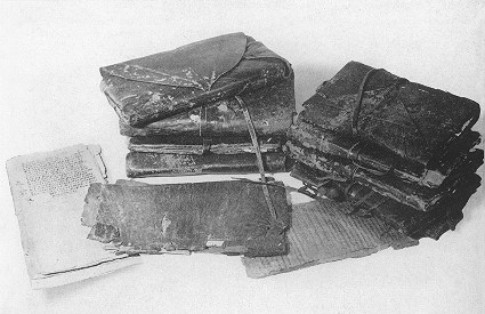
Nag Hammadi Codices, earliest surviving bound books.
Basic Cosmology
The Apocryphon of John. 31 pages. Found in three versions of various lengths in the NHC and in one fragmentary version in a non-NHC text. This is most comprehensive text on the Sophia mythos, giving a relatively coherent overview of all nine episodes.
The Hypostasis of the Archons. 11 pages. Omits features 1 and 2, presents crucial details on the activity of the Archons and Sophia's correction (feature 8).
On the Origin of the World. 30 pages. Found in two
versions in the NHC. Omits features 1 and 2, presents a detailed
treatment of features 4 and 5, including the Gnostic narrative
of Adam and Eve. Ends with a rare apocalyptic passage referring
to feature 8.
The Tripartate Tractate. 78 pages, longest in the NHC. Describes the Sophia Mythos without using the name of Sophia. For instance, Sophia's plunge (feature 3) is called "The Imperfect Begetting of the Logos." Refers to the chief Archon as the Demiurge, a term found in Plato and the Hermetica. Contains important details on episodes 4 through 8, with an emphasis on the salvific action of the Aeon Christos. This text presents the Demiurge as an artisan assisting the Pleromic gods, rather than as an aberration and adversary to them and, by extension, to humanity. In this and other elements, Tri Trac is not genuinely Gnostic. Rather, it more closely resembles Hermetic texts that develop a favorable view of the Demiurge (i.;e., the Archons) as an "artificer" who assists the Pleromic gods in engineering the world-process.
Excerpt from the commentary on the Tripartite Tractate in the Nag Hammadi Reading Plan:
Tri Trac describes the fall of the goddess Sophia in terms of the drama of the spiritual Logos, logos pneumatikos. Sophia as such is not named in the text. The Archons are named outright, and their chief, the demiurge, is specified in sections 6 and 8. Section 5, "Aeonic Life," proceeds in the lofty metaphysical idiom of the opening passages. It states that the Archons do not resemble the eternal beings, the Aeons (71.5), and further explains how the Originator selflessly confers generative power on the Aeons, acting from pleasure, sweetness, and love. "Each one of the Aeons is a name, a code" (73.5): that is to say, the Aeons are generative powers that encode the infinite undefined potentiality of the Originator. "Their begetting is like a process of extension," i.e., emanation, compared to a wellspring of many currents. Unlike the literal, artifactual creation attributed to the father god, Aeonic emanation proceeds "in an imaginary way" (78: 5). I have explained what this means at length in the chapter on "Dreamtime Physics" in Not in His Image.
Trimorphic Protennoia. 15 pages. A revelation discourse presenting the descent of the Aeon Sophia in obscure mystical language. Rich with allusion, although it contains almost no concete elements of cosmology. For an extended discussion of this text, see Sophia's Passion in Coco de Mer, Part One.
The Paraphrase of Shem (41 pages), like The Tripartate Tractate, presents the FGS in abstract language, but even more vaguely. This text is allegorical rather than mythological. Sophia is named, but not as a main character. Paraph Shem features Darkness, Spirit and Nature as the three principal actors in the cosmic drama. In allusion to feature 4, the emergence of the Archons, it refers to an "afterbirth" rather than an "abortion." It is difficult to extract anything relevant to the FGS from this material.
A Valentinian Exposition (8 pages, very fragmentary) describes the Pleroma and paired Aeons (feature 1), omits 2, the projection of the Anthropos, and treats 4 in a manner specific to the Valentinian School, contrasted to the Sethian School, whose version I follow in reconstructing the mythos. This text refers to feature 6 by the phrase, "Jesus and Sophia revealed the creature," and other obscure clues relating to the mysterious co-action of these Aeons in the formation of all species. It uniquely describes Sophia laughing despite Her unexpected exile from the Pleroma; in short, amusing Herself as She can. Val Exp contains the memorable, almost taunting line: "Indeed, the Devil is one of the divinities." Thus the Gnostic view that Ialdabaoth, the chief Archon, who is a diabolic entity working against humanity, is still entitled to divine status, of a kind.
In A Valentinian Exposition, episode 8, the intervention of the Aeon Christos in behalf of Sophia, tends to be treated separately from the evolutionary narrative. The precise manner in which Christos assists Sophia, and the ongoing effects of this intervention for humanity, are deeply problematic issues in Gnostic study. Some texts make Christos and Sophia the paired Aeons who project the Anthropos, the template for the human species; hence, presenting them as the divine parents of humanity. This action occurs within the Pleroma, before Sophia falls. There follows an intervention of Christos into Sophia's evolving world. Some clues on this feature of the scenario occur in the parallel texts The Sophia of Jesus Christ and Eugnostos the Blessed.
NOTE: The most detailed account of the Christic intercession is not found in the NHC or any Coptic Gnostic materials but in Against Heresies by the Christian ideologue Irenaeus.
An Evaluation
In the process of recovering and restoring the FGS I was continually amazed by what the story tells us, and how much it tells us. The scope and richness of the narrative is unparalleled, in my experience. Others may not be so impressed, assuming that it is just one creation story like any other. But my impression is based on the privilege of a lifetime of research in comparative mythology, which most people have not enjoyed. I have seen a lot of parallel material to compare to it, so I can assure you that the material of the FGS is incomparable. In scope, richness, coherence, and explanatory value, it wins hands down over any other creation scenarios. It is the unique case of a genuine, full-blown, participatory myth of planetary evolution.
Consider some of what the FGS shows us and tells us:
# The living fractal beauty of the Aeons, the gods dancing in the galactic core
# The generosity of the Originator, the Prime Aeon, who offers undefined singularities to be developed by the generating Aeons—a perfect compromise of monistic and polytheistic elements
# The emergence of humanity as a singularity in the galactic core, an upsurge of the Originator
# The encoding of the singularity into the human genome (Anthropos)
# The origin of the human species as an imaginative project of divine intelligence
# The empathy of a divine being for the human experiment, leading to the fall of the wisdom goddess
# The nature of the Aeonic endowment of Nous, divine intelligence
# The origin of an alien species or cyborg-type inorganic race, the Archons, due to the impact of the fallen Aeon on elementary matter in the galactic arms
# The embryonic and reptilian (drakonic) forms of the Archons
# The delusional god-complex of the head Archon, Ialdabaoth
# The nature of plane, "error, going astray," distinguished from evil
# The mindset, tactics, and motives of the Archons, including their hallmark of simulation (HAL)
# The insanity of the lord archon, Ialdabaoth, who wishes to convince humankind that he is the sole and supreme creator
# The failed attempt of the Archons to "rape Eve" (genetic intervention?)
# The Sophianic endowment of "luminous epinoia," imagination, to enable mankind to resist the Archons and participate in her designs
# The structural coupling of earth and sun that allows life on earth to thrive even though the solar heat would render the planet uninhabitable,
# The spontaneous organization of Gaian life-plans after extinction, without the need to re-evolve any species (Cambrian explosion, related to the Christic intercession?)
# The Mesotes or intermediary, an intra-psychic phantom providing to humanity a way to see itself as a species and recognize its exceptional but not superior status among animalsExcerpt from Not in His Image, Ch. 23, The Species-Self Connection
The Christos of the Mysteries was understood to be, not an indwelling divine essence, but something that directs us to our animal-human nature. Against the God-self equation, Gnostics asserted the species-self connection. To the ancient seers, Christos had the unique role of an intermediary who connects us as self-conscious individuals to our species identity, and through that identity, to all other species. The Mesotes is the specific term for the intermediary as an intrapsychic presence, accessible to every human being, all the time. Even though the intercession of the Aeon Christos for Sophia’s sake occurred in remote times, it produced a permanent effect that is only evident, however, at the species level of self-conscious awareness. What does it mean for a human individual to be self-conscious at the species level? This is kind of awareness that comes with the humility to see oneself as a member of the animal world, yet belonging to a particular species of animal. It implies that we own our humanity most deeply when we sense the sublime modesty of being a human animal.
Contemporary image of the "vision quest," a solitary vigil undertaken
in nature with the aim of meeting a power animal, an epiphany of
the Mesotes or Intermediary.
# The unique status of the earth as an organic planet captured in an inorganic system,
# The derivation of delusional religious belief from the intrapsychic spell of the Archons
# Interactivity of the living earth and the human species in Sophia's correction, i.e., alignment of her experiment with the Aeonic designs of the galactic core
And that is a partial list, just off the top of my head. I am still amazed every time I go over the entire myth and consider its ramifications, such as the Gnostic theory of error. What impresses me most of all is the coherence of all these features into a single plot trajectory leading to the present moment of human existence on earth, and pointing ahead. The "story arc" (to borrow a term from screenwriting) of the fallen goddess scenario is utterly clear: everything leads up to Sophia's correction. To be involved in it or not is a choice for each person to make, for coevolution with Gaia is a volunteer system. No involvement is possible, however, without coming to know and love the story. In the vision of the Mysteries, the story is the savior.
The FGS answers the two great questions, What are we doing here? and Are we alone?, more thoroughly, clearly, and coherently than any other religious or mythological system. Whether or not it is verifiable in all points, the sacred narrative of the Mysteries is without question the most lucid and comprehensive existential cosmology produced by the human mind. It goes the whole nine yards. Competing visions have been channeled since the days of Blavatsky, of course. Consider the Pleiadian scenario of Barbara Marciniak or the ramblings of Ramtha. Channelled material proliferates with all manner of sci-fi comic book detail, some of which may resemble the FGS, especially the Archon episodes. But as far as I know, the emphasis of channeled material is on the divinity of humanity, our heritage as star children, progeny of the gods, etc, Suchinformation does not emphasize or even include the divinity of the earth, or Sophia's interactivity with humanity, on the one hand, and the Pleromic Aeons on the other. Pleiadian scenarios and the like may contain elements of the FGS, figmens and fragments, but they cannot top it for its overall coherence and applicability to the human condition. The Sophianic myth is the story to guide the species, by which other versions may be evaluated. Such is my conclusion as a comparative mythologist and experimental mystic.
Scientific Correlations
For those who need it, there is considerable scientific correlation to the cosmology of the Sophianic vision story. Recently astronomets detected a double helix at the center of our galaxy. If the Aeons were trying to signal us with the news that the human genome originated in the galactic core, they couldn't have chosen a better way to do it. Also, I have mentioned the discovery of a tunnel from the galactic center running laterally into the spiral arms, suggesting the after-effect of Sophia's plunge. Not in His Image presents extensive correlations between the FGS and Gaia Theory of Margulis and Lovelock.
Mythological Parallels
Clues and fragments of the Sophia Mytho show up in countless different mythologies all around the world. Sacred lore world-wide present aspects of the earth goddess and her story. Indigenous legends are particularly rich in such allusions. They are too numerous to list here, but here is one example from Not in His Image:
To be compelled by her solitary passion and fall out of the Pleroma—such is the unique fate of the goddess Sophia... Gnostic myth recalls the many accounts in myth and folklore of a female deity who falls from heaven or becomes embodied in the earth. For instance, the Thompson Indians of the American Northwest recount this story:
At first Kujum-Chantu, the earth, was like a human being, a woman with a head, and arms and legs, and an enormous belly. The original humans lived on the surface of her belly [The legend recounts how the Old One] transformed the sky woman into the present earth. Her hair became the trees and grass; her flesh, the clay; her bones, the rocks; and her blood, the springs of water.Such parallels (many others could be cited) show that Gnostic cosmology is deeply rooted in indigenous wisdom and reflects a sophisticated version of the native sense for life on earth.
As to objections regarding my possible idiosyncratic additions to the sacred narrative, there are only two: I state that the Anthropos template was deposited in the Orion Nebula (M 43) "like the pattern of dew on a cobweb," and I propose that the moon emerged from the earth as a final surge of the Pleromic plume, a terminal condensation of Sophia's Organic Light secreted externally like a pearl. There is no textual basis for either of these assertions in the Gnostic Coptic materials so far under study.
Recently David Icke has said that the moon is an artificial satellite constructed by aliens and is being used for a broadcasting station to program humanity into a state of blind enslavement. Needless to say, this is quite a contrast to my view of the moon as an index of dakini instruction related to the Shakti Cluster: in other words, an accessory to the Gaian mind and an instrument of enlightment and liberation. I understand that Icke may base his view on the teachings of the African shaman Credo Mutwa. I have a lot of respect for Credo Mutwa, an extraordinary man of genius and heart. His account of ET abduction is chilling. And highly veracious, I would say. I believe that he accurately depicts the predatory alien threat detected by Gnostic seers in the presence of the Archons. ET researcher John Mack (whom I met through the Marion Institute) interviewed Credo Mutwa who gave him a profile of alien predation that I compared closely to Gnostic materials when I was writing early drafts of Not in His Image.
Credo Mutwa attributes some of the information he shares with David Icke to the ETs who abducted and tortured him. This may include the claim that the moon is an artificial body constructed by those same aliens, or may in some way contribute to that claim. However, if much of what Credo Mutwa says is true, all of it is not necessarily true. Curiously, the Zulu shaman himself notes that the predatory aliens are liars, a fact well-known in his tradition, apparently. They are in Gnostic terms agents of error and deceit—as I have exhaustively argued on this site, in interviews, and in my book, Not in His Image. In Severed Rose I explain how I fell for the Arthontic lie of salvationism, even though I attempted to see it in a mystical framework rather than as an item of dogmatic faith. The point is, I saw the lie and corrected it.
Well, I wonder if Credo Mutwa would tell the world what lie, if any, he has heard from the alien predators?
jll : 3 October 2010 Flanders

